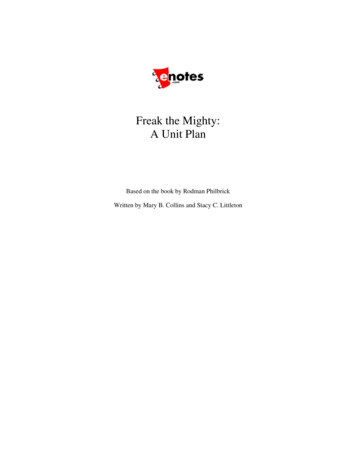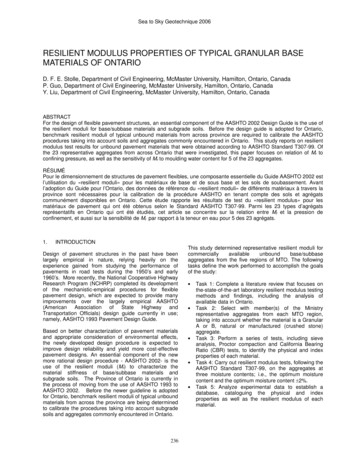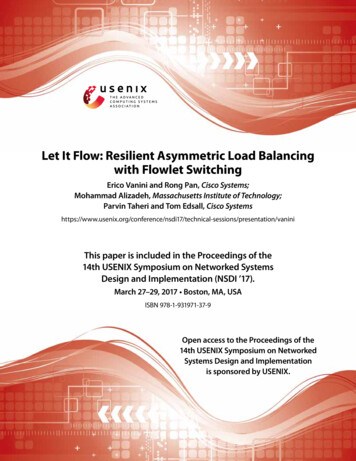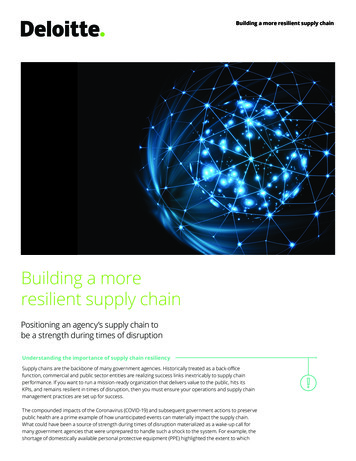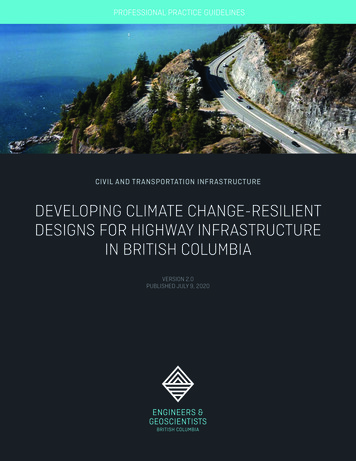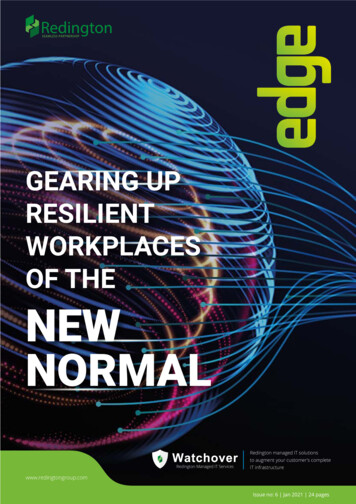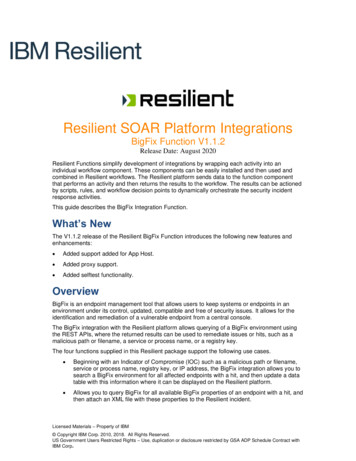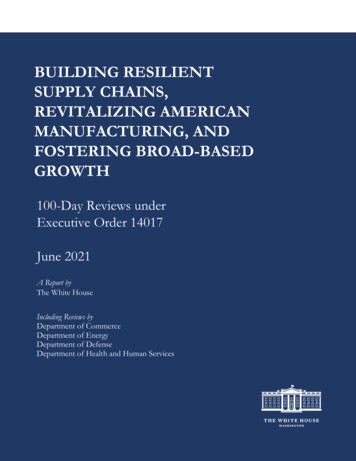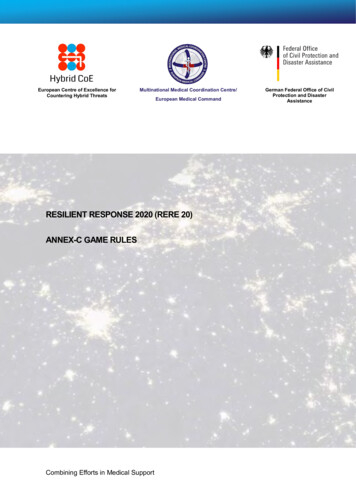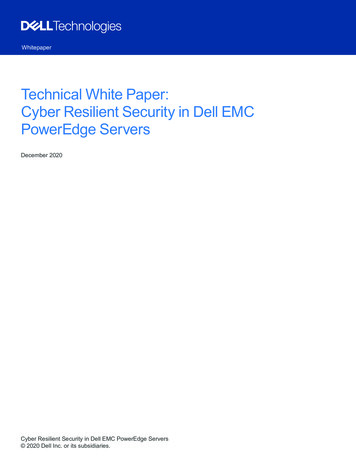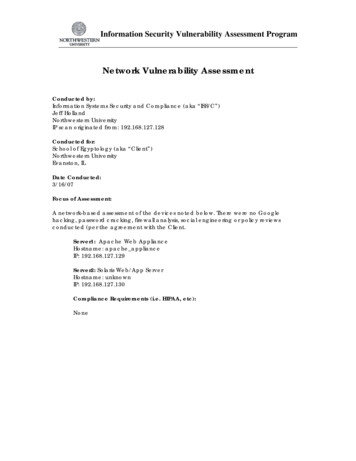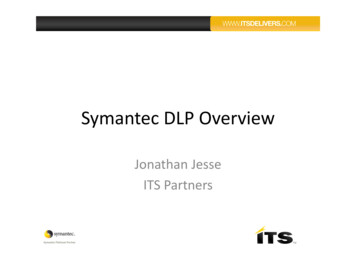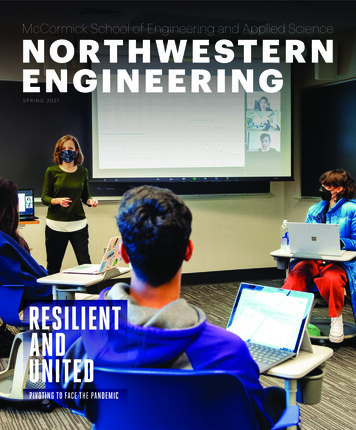
Transcription
McCormick School of Engineering and Applied ScienceNORTHWE STERNENGINEERINGSPRING 2021RESILIENTANDUNITEDPIVOTING TO FACE THE PANDEMIC
REGENERATION RAINBOWCaptured via scanning electron microscopy, these rainbow-colored,micron-sized pillars can be used as an underlying substrate for cellculture to test the mechanical forces cells exert on different biomaterialcoatings. This process is used to screen new biomaterials that couldbe implanted as biodegradable scaffolds to guide regeneration ofdamaged tissues or organs.Image by Nick Sather (Samuel I. Stupp Laboratory/Simpson Querrey Institute)
“Let me emphasize the word ‘together.’Though we have been physicallydistanced—some of us operatingfrom the other side of the world andothers working mere blocks fromcampus—we remain one strong,connected community.”NORTHWESTERN ENGINEERINGSPRING 20214NEWS146COVID-19 NOTES8LAB NOTES1416A F U T U R E P L AY E D W I T H O U T B AT T E R I E SBattery-free Game Boy acts as a blueprint for sustainable electronics16GREETINGS FROM NORTHWESTERN ENGINEERINGAnticipating and adapting to change is what engineers do.We need only to think back to a year ago to realize how quicklychanges can come and shift our worldview forever.This issue of Northwestern Engineering is full of stories thatshow how well our community has faced COVID-19 togetherand adjusted with creativity and perseverance.Let me emphasize the word “together.” Though we have beenphysically distanced—some of us operating from the otherside of the world and others working mere blocks from campus—we remain one strong, connected community. This year, wehave forged and tested bonds in research, in teaching, and,importantly, with each other.In this issue you will find stories that show how our studentsand faculty have handled this unusual year’s challenges—bypivoting research topics, adjusting pedagogy, juggling familyobligations, and more—all while playing the dual roles ofoffering and receiving support.This is not the first time in Northwestern’s history that we haveweathered intense change. In this issue, we highlight how theGI Bill reshaped our campus after World War II , with studentsliving in Quonset huts quickly built throughout campus.As always, the challenge tested Northwestern’s mettle, andwe emerged stronger.NO STRANGER TO CHANGEChallenges inspire innovation, which in turn fosters newbusiness opportunities. Now, under Hayes Ferguson’s leadershipat the Farley Center, we will take entrepreneurship educationto a new level.Campus faced different challenges in earlier era of transformationMeanwhile, we continue work on pressing problems of ourtimes—including environmental issues. The Center for SyntheticBiology is working on possible routes to produce cleaner waterby reprogramming cellular machineries, while Josiah Hesterused a battery-free Game Boy to exemplify what is possiblein the realm of environmentally sound electronic devices.McCormick faculty create learning tools, emphasize mentorship20REFINING REMOTE2024E L E VAT I N G E N T R E P R E N E U R S H I P E D U C AT I O NHayes Ferguson brings new vision to Farley CenterThese stories feature only a few of those who have perseveredin our community. I applaud all of you for standing up tothese unexpected challenges with equal amounts of graceand tenacity. I am grateful for your ongoing support.As always, I welcome your feedback.2428McCORMICK WHERE WE AREUnited, we meet COVID-19 challenges2834T O S AV E T H E E N V I R O N M E N T, U S E N AT U R E ’ S C O D ECenter for Synthetic Biology reprograms cellular machinery36JULIO M. OTTINOH U M A N - M A C H I N E C O L L A B O R AT I O N V I S U A L I Z E S M U S I CDean, McCormick School of Engineering and Applied Science34Blending of artificial intelligence and music creates beautiful results38THE OPTIMIZERJorge Nocedal sees human connections as integral to discoveryOn the Cover With COVID-19 restrictions in place,Northwestern offers hybrid classes, including this oneled by Professor Karen Smilowitz, with some studentstaking part on campus and others attending virtually.Northwestern Engineering is published bythe Robert R. McCormick School of Engineeringand Applied Science, Northwestern University,for its alumni and friends.Photography by Steven E. Gross 2021 Northwestern University.All rights reserved.Some images predate COVID-19 regulations.40CLASS NOTES49BIG IDEAExecutive Director of Strategic Initiativesand Marketing: Kyle DelaneyManaging Editor: Julianne HillProduced by The Grillo Group, Inc.3638
C O L G AT E , M A H M A S S A N I E L E C T E D T O N AT I O N A LACADEMY OF ENGINEERINGNorthwestern Engineering’s J. Edward Colgate and Hani Mahmassani,leaders in robotics and in transportation and operations, respectively,were elected to the National Academy of Engineering, one of thehighest professional distinctions awarded to an engineer.They are among the 106 new domestic members and 23 newinternational members. Current members elect new inducteesof the NAE , founded in 1964.Colgate, professor of mechanical engineering, primarily focuseson human-robot interaction, and has worked extensively in theareas of haptic (touch) interface, cooperative robotics, remotemanipulation, and advanced prosthetics.Mahmassani, who directs the Northwestern University TransportationCenter, is William A. Patterson Distinguished Chair in Transportationand professor of civil and environmental engineering and (bycourtesy) of industrial engineering and management sciences.“WE ARE EXTREMELY PROUD THAT ED AND HANI HAVE BEEN RECOGNIZED AT THE HIGHEST LEVEL IN OUR FIELD.THEY ARE BOTH OUTSTANDING AS INNOVATORS, RESEARCHERS, AND EDUCATORS, PUSHING THE LIMITS OFTHEIR FIELDS.” J U L I O M . O T T I N ODean, Northwestern EngineeringD E S I G N - A -T H O N I D E A S R I S ETO THE OCCASION90KELLOGG, McCORMICK ANNOUNCE MBAi JOINTDEGREE PROGRAMThe Kellogg School of Management and the McCormick School ofEngineering launched an MBA i joint degree program at the intersection of business and technology management. The accelerated,five-quarter offering responds to a growing and global need forleaders who can spearhead strategic, business-driving innovationwhile understanding the complexities and nuances of the technologies that enable it.The program is designed for students with strong technology workexperience or academic grounding who are interested in a focusedcurriculum covering machine learning, robotics, computationalthinking for business, introductions to the frontiers of scienceand technology, and how data science and artificial intelligencedrive innovation.The MBA i program also includes an experiential summer quarterthat allows students to gain work experience.4Northwestern Engineering Spring 2021Percent waterby weightof a materialdeveloped bySamuel Stuppand MonicaOlvera de la Cruzthat acts asa soft robot2Faculty electedto the NationalAcademyof InventorsThe McCormick Design-A-Thon 2020 hadan important goal: harness the power ofNorthwestern students’ thinking to find waysto build community during the pandemic.Just as Fall Quarter started, 180 studentsrose to the occasion.The virtual hackathon-style event challengedthe 37 participating teams to answer,“How might we understand and reimagineour ‘community’ in the age of COVID-19for students at Northwestern University?”Twelve finalist teams presented three-minutevideos of their concepts to a panel of judgesthat included Northwestern Engineeringfaculty and alumni.After competitors presented ideas rangingfrom a program that mimics chance encounters on Sheridan Road to an app that connects music lovers, team Tech Labyrinth’sidea, Roomz, emerged the winner. The platform creates virtual rooms where studentscan watch live lectures with classmatesand collaborate and discuss the materialusing a pause feature.One McCormickLecture SeriesHighlights DiverseStudent GroupsTo build community and enhance connectivityduring the COVID-19 pandemic, NorthwesternEngineering launched the One McCormicklecture series as a venue for presenting ideas.The virtual series focused initially on thestudent experience, including diversity,health and wellness, and student success.Fall presentations included leaders ofstudent groups such as the Northwesternchapters of the National Society ofBlack Engineers, the Society of WomenEngineers, and the Society of AsianScientists and Engineers.Each organization’s leaders explained theirrole in the McCormick School of Engineeringcommunity and what their membershipprovides to the school specifically and theUniversity as a whole, such as volunteerismand mentorship.“The best thing faculty can do ismake sure they have a good enoughconnection with students so ifthey are having issues within theirclasses, they’re comfortable talkingto them—and to keep havingthose conversations.”L E A H P AY N EJunior, Chemical Engineering,President, Northwestern chapter of NSBE66Women inComputingmembers whoattended the2020 VirtualGrace HopperCelebration26,000Moviesanalyzed byLuís Amaralto count howmany womenworked infilm from1910 to 2010364Master’s andPhD graduatesin DecemberS C H O O L O F C O M M U N I C AT I O N , M c C O R M I C KL AU N C H C E N T E R FO R H U M A N - C O M P U T E RINTERACTION DE SIGNNorthwestern Engineering and the Northwestern School ofCommunication launched the Center for Human-ComputerInteraction Design (HCI D), which aims to develop thefuture of human and computer interaction.The center’s core vision and values build on Northwestern’sunique interdisciplinary, socially engaged, people-centeredapproach to interaction and design. It also supports researchersin their pursuit of new interaction paradigms that will fostera collaborative, sustainable, and equitable society.To achieve those goals, HCI D draws upon the University’spioneering leadership in interaction and design research,leveraging Northwestern’s history of research among diversedisciplines—including communication, computer science,design, learning sciences, several areas of engineering,medicine, and psychology.INAUGURAL PEPPER, ACHENBACH CHAIRS NAMEDKimberly Gray and Yonggang Huang were named the inauguralholders of Northwestern Engineering’s two newly endowed chairs.Gray is Roxelyn and Richard Pepper Family Chair in Civil andEnvironmental Engineering, a rotating professorship held by thedepartment chair. She is professor of civil and environmentalengineering and (by courtesy) chemical and biological engineering. The gift was endowed by alumni Roxelyn (Roxy) (’53) andthe late Richard Pepper (’53).Huang, a faculty member since 2007, serves as Jan and MarciaAchenbach Professor in Mechanical Engineering. A gift fromthe late Professor Jan Achenbach and his wife, the late MarciaAchenbach (’65 MA), supported this professorship.News5
NORTHWESTERN LEADSNIH PROGRAMFA S T-T R A C K I N G C O V I D - 1 9TESTING TECHNOLOGIESThe Center for Innovative Point-of-CareTechnologies for HIV/AIDS at Northwestern(C-THAN) is leading a program from theNational Institutes of Health (NIH) designedto fast-track new technologies capable ofincreasing COVID-19 testing capacity upto 100-fold above current standards.Clinical-Grade WearablesOffer Continuous Monitoringfor COVID-19Northwestern University researchers caution that consumer-gradewearables are not sophisticated enough to monitor COVID-19.The team, led by Professor John Rogers, published a perspectivein Science Advances in which researchers differentiate betweenpopular consumer electronics fitness trackers, which sit on a wristor finger, and clinical-grade monitoring systems, which sit at thebase of the throat.This follows the introduction by Rogers’s group and researchersat Shirley Ryan AbilityLab of a novel wearable device and setof data algorithms specifically tailored to catch early signs andsymptoms associated with COVID-19 and to monitor patientsas the illness progresses.The program, called Rapid Accelerationof Diagnostics (RAD x), is supportedby a 6.7 million supplementary grantfrom NIH that aims to develop and scaletechnological innovations for testing toreduce the risk of future outbreaks andto support efforts to return to in-personactivities, like school and work.RAD x comprises four stages for tech-nologies that demonstrate notableinnovations to the COVID-19 testingprocess. C-THAN , a member of NIH ’sNational Institute of Biomedical Imagingand Bioengineering Point-of-CareTechnologies Research Network, isleading RAD x in collaboration withother network partners.“X-RAYS ARE INEXPENSIVE AND ALREADY A COMMON ELEMENT OF ROUTINE CARE. THIS COULD POTENTIALLYSAVE MONEY AND TIME—ESPECIALLY BECAUSE TIMING IS SO CRITICAL WHEN WORKING WITH COVID-19.”A G G E L O S K AT S A G G E L O S Joseph Cummings Professor of Electrical and Computer EngineeringAI DETECTS COVID-19 ON CHEST X-RAYS WITHACCURACY AND SPEEDNorthwestern University researchers developed an artificialintelligence (AI) platform that detects COVID-19 by quicklyanalyzing X-ray images of the lungs.Called Deep COVID-XR , the machine-learning algorithm outperformed a team of specialized thoracic radiologists—spottingCOVID-19 in X-rays about 10 times faster and 1 to 6 percent moreaccurately. Typically, getting results for COVID-19 tests cantake hours or days.The study’s authors, including Professor Aggelos Katsaggelos,say their goal is not to replace actual testing. Instead, physicianscould use the AI system to rapidly screen patients admitted tohospitals for reasons other than COVID-19 and potentially flagpatients for isolation and testing. Faster, earlier detection ofthe highly contagious virus potentially could protect healthcareworkers and other patients by triggering the positive patientto isolate sooner. The researchers note that X-rays are routine,safe, and inexpensive.1,000“A CONVENTIONAL WEARABLE DEVICE, SUCH AS A FITNESS TRACKER, SITS ON THE WRISTOR FINGER—NOT THE ANATOMICAL LOCATION THAT IS MOST RELEVANT TO COVID-19.”JOHN A. ROGERSLouis Simpson and Kimberly Querrey Professor of Materials Science and Engineering, Biomedical Engineering, and Neurological SurgeryChemical modulation layerFA C E M A S K A I M S T O D E A C T I VAT EVIRUS TO PROTECT OTHERSResearchers led by Professor Jiaxing Huang developed a conceptfor a mask that aims to make the wearer less infectious. Thecentral idea, supported by the National Science Foundationthrough a Rapid Response Research (RAPID ) grant, is to modifymask fabrics with anti-viral chemicals that can sanitizeexhaled respiratory droplets.Releasedrespiratorydroplets6Northwestern Engineering Spring 2021ModifiedrespiratorydropletsBy simulating inhalation, exhalation, coughs, and sneezes, theresearchers found that non-woven fabrics used in most maskswork well to demonstrate the concept. A lint-free wipe with just19 percent fiber density, for example, sanitized up to 82 percentof escaped respiratory droplets by volume. Such fabrics donot make breathing more difficult, and the on-mask chemicalsdid not detach during simulated inhalation experiments.AI Tool a Potential Timesaverfor COVID-19 ResearchersNorthwestern Engineering computer scientists are aiming to speedup treatments for COVID-19 by making researchers’ jobs easier.The team, led by Professor Diego Klabjan and graduate studentNing Wang, developed a tool called CAVIDOTS (CoronavirusDocument Text Summarization) that searches through scientificliterature and predicts the most useful results for each user. Afterpulling documents of interest, the tool uses artificial intelligenceto generate a short, easy-to-skim summary of each paper.Initially developed to sift through and analyze financial news,the tool was shifted toward helping the medical communitysort through thousands of research papers related to the virus,saving them time by guiding them to key information.Masks per dayproduced by HARP,a method of 3Dprinting developedby Chad Mirkin30,000Documents inthe COVID-19 OpenResearch Datasetanalyzed byCAVIDOTS, whichpredicts the mostuseful scientificliterature forresearchersHOW WELL DOE S COVID -19P U B L I C P O L I CY A L I G NWITH SCIENCE?The rapid development of effectiveCOVID-19 vaccines is a powerfulexample of how the business and scientific worlds can successfully workin tandem. But there is a thornier,related question: How well does public policy co-evolve with science?To understand the co-evolution ofscience and policy, Professor DashunWang, as part of a team, analyzed tensof thousands of policy documentsworldwide. Team members studied thescientific research those documentsdrew on, as well as COVID-19-relateddocuments from intergovernmentalorganizations like the World HealthOrganization. The team was interestedin how the type and volume of policydocuments were influenced by thenumber of COVID-19 cases in a country,as well as how closely policymakingrelied on scientific research.Overall, their study revealed good news,finding that global policy attention toCOVID-19 closely follows the number ofcases and draws heavily on the rapidlyevolving science.“COVID policies rely on validated science,”Wang says. “So, there’s great synchronybetween policy attention, the realitiesof the outbreak, and sound research.”C O V I D -1 9 Notes7
MEDICAL DEVICE USING NORTHWESTERN-INVENTEDBIOMATERIAL RECEIVES FDA CLEARANCESWARMING ROBOTS AVOID COLLISIONS,TRAFFIC JAMSAn orthopedic medical device fabricated from a biomaterialpioneered in Professor Guillermo Ameer’s laboratory receivedclearance from the US Food and Drug Administration foruse in an implantable medical device. The biomaterial, calledCITREGEN , is the first thermoset biodegradable syntheticpolymer to receive such approval.“CITREGEN is an unprecedented andinnovative bioresorbable biomaterialtechnology developed to supportthe body’s normal healing processand promote tissue regeneration.When used to fabricate devices forreconstruction of tissues, such asligaments, blood vessels, bladder, andbone, results have been impressiveand beyond our expectations.”GUILLERMO AMEERDaniel Hale Williams Professor of BiomedicalEngineering and SurgerySponge Could CleanUp Oil SpillsA team led by Professor Vinayak Draviddeveloped a highly porous sponge thatselectively soaks up oil in water.With an ability to absorb more than 30 timesits weight in oil, the sponge could be usedto clean up oil spills inexpensively, efficiently,and without harming marine life. After theoil has been squeezed out of the sponge, itcan be reused many dozens of times without losing its effectiveness.The sponge’s secret lies in a nanocompositecoating of magnetic nanostructures anda carbon-based substrate that is oleophilic(attracts oil), hydrophobic (resists water), andmagnetic. The nanocomposite’s nanoporous3D structure selectively interacts with andbinds to the oil molecules, capturing andstoring the oil until it is squeezed out.8Northwestern Engineering Spring 2021To help bring self-driving vehicles closer to reality, ProfessorMichael Rubenstein developed the first decentralized algorithmwith a collision-free, deadlock-free guarantee.Rubenstein’s research team tested the algorithm in a simulationof 1,024 robots and on a swarm of 100 real robots in the laboratory.The algorithm views the ground beneath the robots as a grid.By using technology similar to GPS , each robot knows where itsits on the grid. Before making a decision about where to move,each robot uses sensors to communicate with its neighbors,determining whether or not nearby spaces within the grid arevacant or occupied.With citrate as its key component, CITREGEN is the core materialtechnology in the CITRELOCK Interference Screw System. Setto be produced and marketed by Acuitive Technologies Inc. thisyear, the system is intended for soft tissue attachment or fixingligaments and tendon graft tissue in joint surgeries.As CITREGEN is absorbed by the body after surgery, it leavesbehind a biocompatible ceramic structure metabolized by thebody’s tissue. This bioresorption process avoids degradationand chronic inflammation that commonly accompany ot
MBA. i joint degree program at the inter-section of business and technology management. The accelerated, five-quarter offering responds to a growing and global need for leaders who can spearhead strategic, business-driving innovation . Northwestern Engineering’s J.
